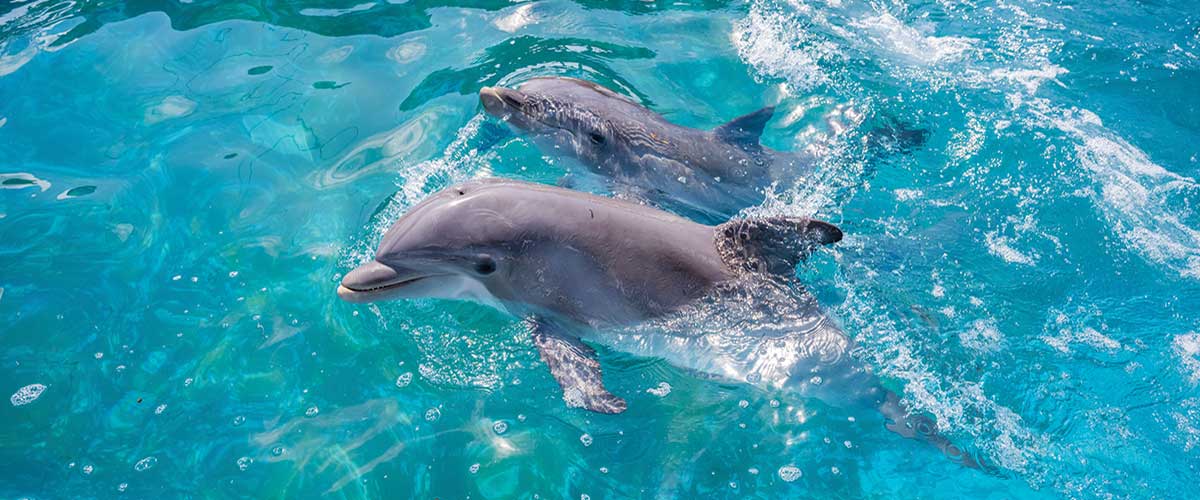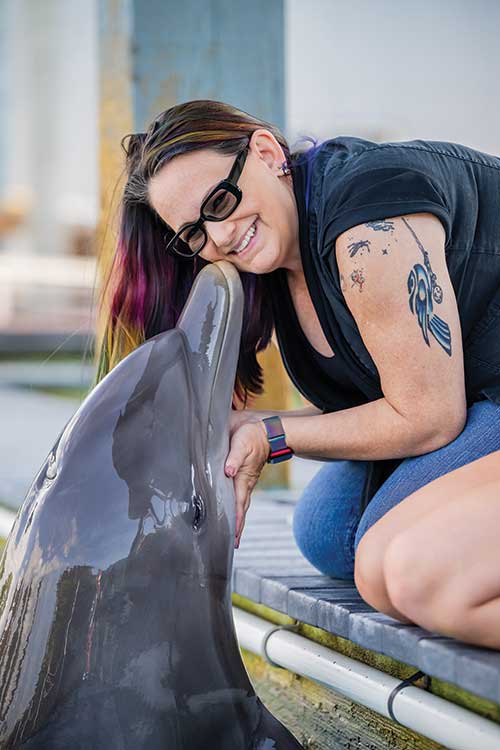Joy in Sound and Motion
Posted on May 30, 2025 by Teri Greene

 In her research of emotions in animals, Dr. Heidi Lyn, a psychology professor at South,
travels in the wake of dolphins — to Bermuda, the Florida Keys and here, at the Institute
for Marine Mammal Studies in Gulfport, Mississippi — where she studies them as they
interact with people and with each other.
In her research of emotions in animals, Dr. Heidi Lyn, a psychology professor at South,
travels in the wake of dolphins — to Bermuda, the Florida Keys and here, at the Institute
for Marine Mammal Studies in Gulfport, Mississippi — where she studies them as they
interact with people and with each other.
“I have a great story about dolphin telling a joke,” says Dr. Heidi Lyn, professor and Joan M. Sinnott chair of psychology at the University of South Alabama.
Lyn, who runs the Comparative Cognition and Communication Lab in the Department of Psychology and also is a faculty member at the Stokes School of Marine and Environmental Sciences, gets along well with dolphins — as well as bonobos and other apes, hermit crabs, walruses, and dogs and cats.
She looks at animal emotions through a new lens. For years, studies into the internal lives of animals have aggressively leaned to the negative, with scientists tracking depression, fear, anger and grief; those studies have been useful in helping people struggling with the same emotions, but they don’t address the full array of feelings animals experience.
Lyn tracks animal happiness, seeking, documenting and analyzing bursts of intense positive emotion — what could be defined as joy — through animals’ vocalizations and movements. It’s not exclusive to dolphins, but they’re the most fun and the most challenging to work with, she says.
“There’s no way to actually make a dolphin do anything, right?” she says. “You can’t put a harness on them and force them to do something — they’re 300 pounds, they’re incredibly fast, and they live in the water.”
But the most adorable of apex predators does love to play. Early researchers pinpointed the specific vocalizations dolphins made when told they were “correct” during training. The sound became known to some as the “victory squeal” and can be accompanied by a small leap into the air, something Lyn sees a lot.
Which brings us back to the joke: As researchers watched from a tower, an instructor signaled for the dolphin to pick up a small toy and put it in a basket at the other end of the pool. Instead, the dolphin stopped midswim and put the toy on a leaf that was floating in her pool. When the instructor let her know that was wrong, she didn’t behave like admonished dolphins usually do — swimming away quietly, as if they’re embarrassed. Instead, she looked up to the group of scientists, leapt into the air and let out a loud squeal similar to the victory squeal. It was the behavior of a young child trying to get a group of adults to laugh at her antics.
“She was like, ‘This is so hilarious,’” Lyn says. And it’s not isolated behavior.
“We see dolphins coming over to boats that are going really fast and surfing behind them, and that clearly is a behavior — they’re interrupting whatever it was that they were doing in order to be part of that behavior. So we have no other explanation for it, other than play.”
For a long time, it was assumed that only young dolphins engaged in play. But as still photography, video and audio technology improved exponentially over the years, researchers in the wild have learned that dolphins play throughout their lives.
Recent research, funded in part by the Templeton World Charity Foundation, took Lyn and her students to the Dolphin Research Center in the Florida Keys and Bermuda’s Dolphin Quest dolphin encounter attraction. She regularly visits the Institute for Marine Mammal Studies in Gulfport, Mississippi, and Gulf World Marine Park in Panama City Beach, Florida.
Her team is looking for new ways to bring out the same joyous vocalizations and movements that dolphins exhibit when figuring out a puzzle, receiving positive feedback or surfing in a fast boat’s wake.
Creating a Partnership
Much of Lyn’s research encourages positive animal-human interactions. Those interactions have a huge ripple effect. Beginning in the mid-20th century, animal trainers took a harshly negative approach to training animals. Punishment guided learning: think back to big cat trainers with their whips.
“It was keeping them in fear to try and stop their wildness from coming out,” Lyn says. “But we’ve learned that ruling by fear is a terrible way to do things, because if it goes too far, it breaks, and there’s violence.
“If we spin it around, then we have a cooperative animal who wants to work with you because they're excited about it. They're doing their best, and you're doing your best for them. That sets up the possibility for a different kind of partnership.”
That applies across the animal kingdom: Rats emit a high-pitched squeal when they’re tickled; scientists have used acoustic equipment so that it’s audible to humans; apes, when tickled, respond with a deep, breathy panting similar to human laughter. Even our pets have complex feelings.
To find true canine joy, dogs were trained to sit still long enough to endure an fMRI exam, which reveals brain activity in real time.
What part of a dog’s brain lights up when it’s happy and alert? The limbic system, home to the amygdala, which processes emotions like fear and anxiety, but also positive ones, like happiness. The system is present in all mammals — and a long list of nonmammalian vertebrates.
If we learn what triggers happiness in animals, we can use those tools to create a more balanced human world, Lyn says.
“If we start with this idea of ‘How do we trigger positive emotion in animals?’ that gives us a better understanding of how to trigger positive emotion in people, potentially,” she says. “And it gives us this other potential of figuring out how better to communicate and cooperate with animals in the future.”
Click here to view the current issue of South Magazine


